Table of contents
- Exhaust tuning and performance comparison at Akrapovic Full pipe
- The timing of pressure and vacuum determines the power
- Every engine layout and every firing order has a special feature
- Adapted injection program advisable
- Technology: types of dampers
- Comparison: measured values
- Brief portrait: Racing Department
- Brief portrait: Akrapovic
- With all three variants, the ZX-10R draws a clean performance curve
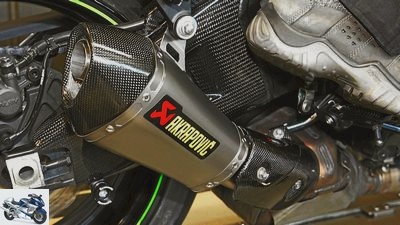
Bilski

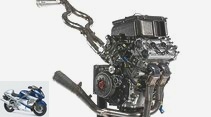
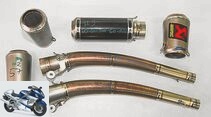
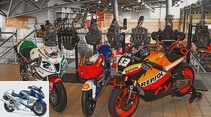
27 pictures
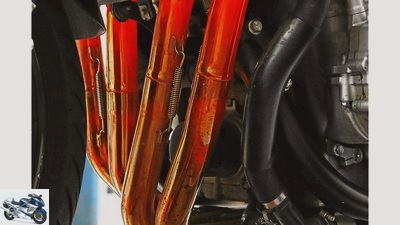
fact
1/27
Three parameters mainly determine the potential of a bend: the diameter of the pipes, their shape and length.
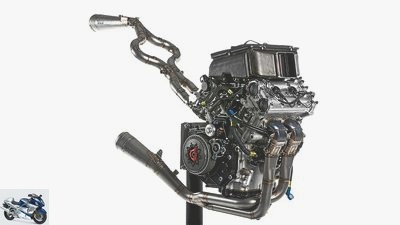
Akrapovic
2/27
Don’t be afraid of exotic cars: the KTM-V4 from the premier class from 2005 also has a Slovenian exhaust.
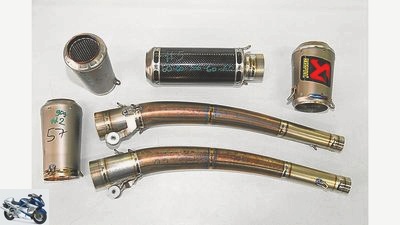
Akrapovic
3/27
Everything for more KTM power: Experiment with different tube attachments.
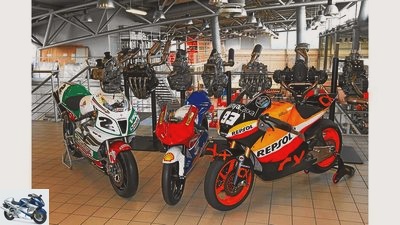
Bilski
4/27
Part of the impressive racing collection: Honda VTR 1000 SP 2, Moto3 bike from the new “Shell Advance Asia Talent Cup”, Marc Márquez ‘Moto2 world champion bike 2012 (from left to right).
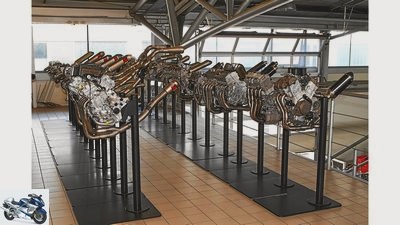
Bilski
5/27
Real treasures: engines from the manufacturers of the premier class of the last 15 years.
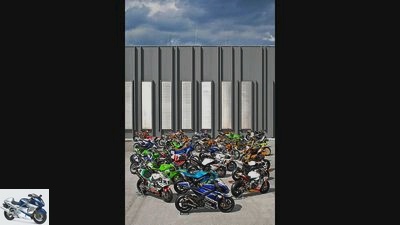
Akrapovic
6/27
In 1999 the company moved to larger halls within the town of Ivancna Gorica. The success story continues to this day, around 700 people currently work for the company. Another move is due this year. The entire production is outsourced to Crnomelj, around 60 kilometers away.
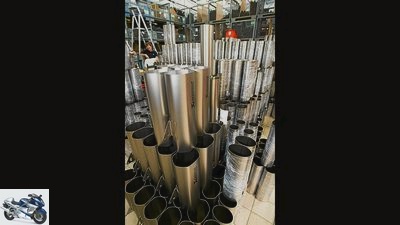
Bilski
7/27
There you get a pipe! Lots of exhaust covers, some ready to assemble.
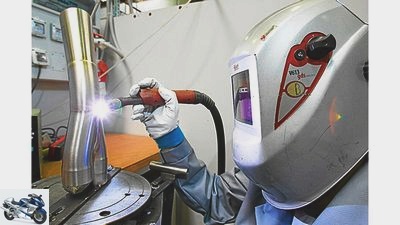
Bilski
8/27
Nothing comes from nothing: Akrapovic’s welds are legendary.
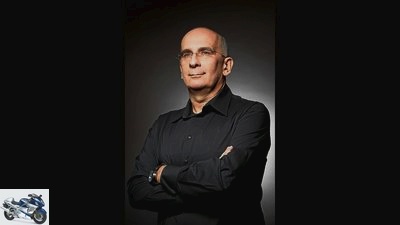
Akrapovic
9/27
The boss: Igor Akrapovic founded his company in 1990 and is still running it today. The company is growing in the double-digit range every year.

Bilski
10/27
Faithful soul: The gentleman’s first name is also Igor. With the surname Ržek and the employee number 0001.
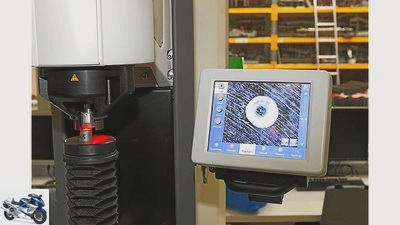
Bilski
11/27
The in-house laboratory constantly checks the material quality. In this case the hardness of titanium.
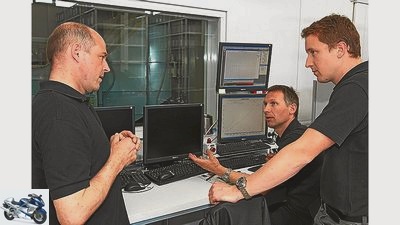
Bilski
12/27
How do you get maximum punch out of the bikes? Discussions with the R & D department.
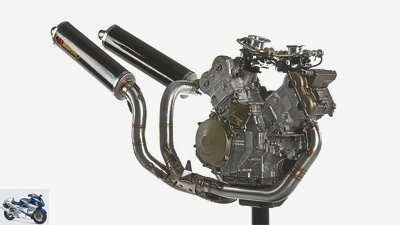
Akrapovic
13/27
Tough nut: The world championship project with the Honda VTR 1000 SP 2 between 2000 and 2002 was one of the most extensive.
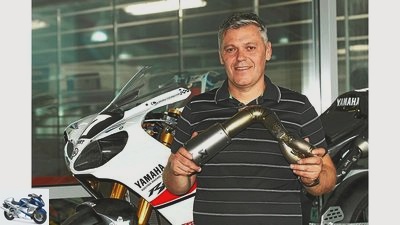
Bilski
14/27
Slavko Alojz Trstenjak, head of the racing department at Akrapovic: “Worldwide, including the off-road sector, we currently supply 66 teams with a total of 174 drivers.”

Bilski
15/27
Current Moto3 factory racer from KTM in a power check with exhaust as a test vehicle. We were allowed to take the picture because of an ingenious deal between Akrapovic and KTM: “Photo against more ponies.”
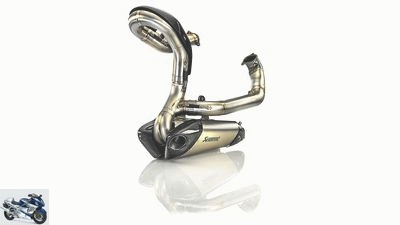
Štokelj
16/27
As with this system for the Ducati Panigale, artistically curved pipes primarily serve to achieve good flow behavior.
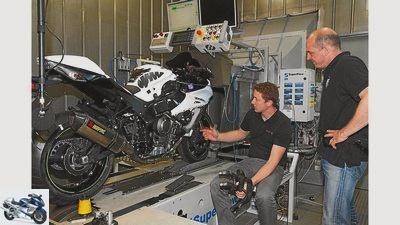
Bilski
17/27
Complete racing system. Unsurprisingly, it delivers the most punch. The stationary noise at half the nominal speed (6500 rpm) is 108.8 dB.
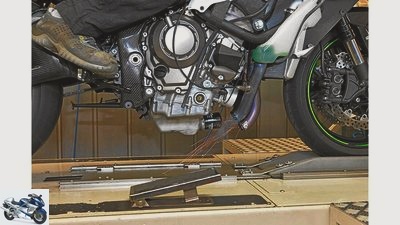
Bilski
18/27
Worst performance with a shortened manifold despite the lowest counter pressure. Standing noise: hellish 120.2 dB.
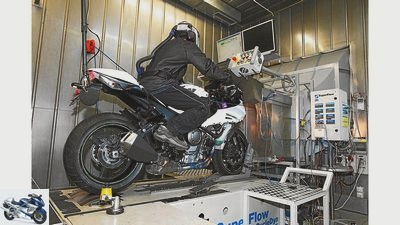
Bilski
19/27
The original system with decent performance and a quiet 96.5 dB.
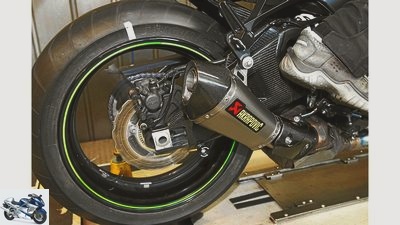
Bilski
20/27
Light, stylish and with good performance: slip-on. Standing noise: 97.4 dB.
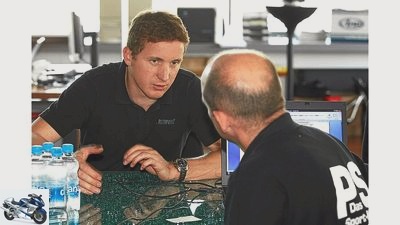
Bilski
21/27
Jaka Klemenc, Technical Manager R & D von Akrapovic: “The art of building the exhaust consists in making optimal use of the various pressures in the system.”
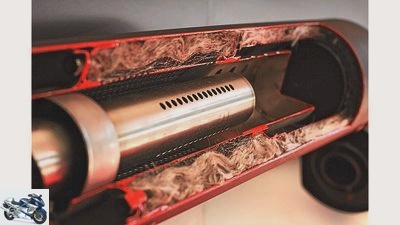
Akrapovic
22/27
The comparatively simple construction of the absorption damper. Its advantages: light, inexpensive, little counter pressure.
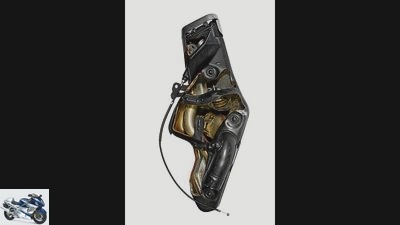
mps photo studio
23/27
A reflection damper, on the other hand, is much more complicated: chambers, pipes, coils. The Fireblade’s damper takes it to extremes.

Bilski
24/27
The test bench tire is a custom-made product. Hard mixtures reduce the power loss.
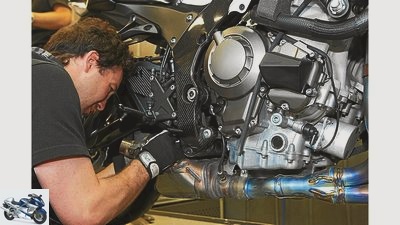
Bilski
25/27
Screw until the tool glows: many thanks to the guys from Akrapovic!
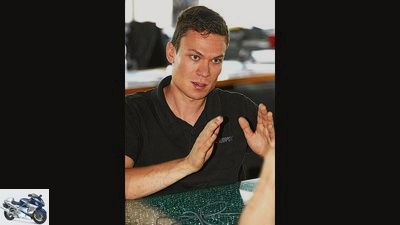
Bilski
26/27
Ziga Zadnik, Head of Development at Akrapovic: “We are currently overseeing 40 projects. For some time now we have also been developing systems for custom bikes and scooters. “
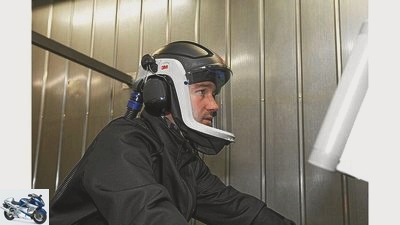
Bilski
27/27
What looks like Major Tom’s spacesuit is used to protect personnel during test runs – including fresh oxygen supply.
accesories
Exhaust & silencer
Exhaust tuning and performance comparison at Akrapovic
Exhaust tuning and performance comparison at Akrapovic
Full pipe
Content of
Exhaust pipes are not an unbearable evil. Instead of cutting off power, the systems provide plenty of steam. Why? Read the story about our visit to Akrapovic, check and take a look at the performance comparison!
Volkmar Jacob
06/17/2014
A hell of a noise penetrates the upper floor. On the dynamometer on the floor below, a current Moto3 World Championship racer thunders as hard as it gets. It’s hard to believe that a 250cc single cylinder can cause such a roar! KTM has asked its exhaust partner Akrapovic for more power for the Austrian speedsters, because the Hondas are getting closer and closer to them in the world championship. Today, a week and a half and twelve exhaust configurations later, the success story comes: The guys in the racing department actually got more punch out of the engine – all with the help of the right pipe.
Buy complete article
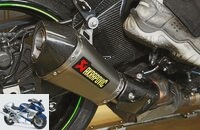
Exhaust tuning and performance comparison at Akrapovic
Full pipe
10 pages) as PDF
€ 2.00
Buy now
The Slovenian manufacturer is of course silent about how much power was added, as well as about the absolute performance. It should be one or the other pony more than the 55 HP rumored by the scene for such bikes. But why is an exhaust so important to performance? And what do manufacturers have to consider when building a system? To find out, we look at the research team & Development department (R & D) in the factory in Ivancna Gorica / Slovenia for almost two days over the shoulders. Although no World Cup racer is used as a test vehicle, a current Kawasaki ZX-10R with different exhaust variants runs numerous test bench runs.

Bilski
Complete racing system. Unsurprisingly, it delivers the most punch. The stationary noise at half the nominal speed (6500 rpm) is 108.8 dB.
“When developing an exhaust, it is important to make optimal use of the pressure waves that arise when the burned mixture is expelled,” explains test manager Jaka Klemenc. “Ideally, the exhaust reflects these high-energy impulses in such a way that a negative pressure is created directly behind the opening exhaust valve. This draws the exhaust gases out of the combustion chamber and creates space for fresh gas. ”Reduced to a simple formula, this means: the more fresh gas that can get into the combustion chamber, the better the filling. And the better the filling, the higher the performance.
So it is because of the more favorable pressure conditions that the Kawa generates more punch with a full exhaust than with the shortened manifold. Consequently, the popular opinion that the lowest possible counterpressure increases performance is also not true. This counter pressure is made up of pressure waves moving back and forth and flow losses and averages between 50 and 250 millibars. The individual impulses, however, reach around two bar. Other interesting numbers? Here you go: The pressure waves move at the speed of sound, depending on the temperature this is up to 2000 km / h! The average flow velocity in the exhaust is 360 to 550 km / h.
Follow PS on Facebook
The timing of pressure and vacuum determines the power
First and foremost, the sheer level of back pressure does not affect engine performance. Rather, the timing of pressure and negative pressure determines the power. The manifold layout significantly controls this timing. The shape and location of the pipe junction as well as the design and location of the collector are also important. In contrast, the lowest possible back pressure in the end pot generally promotes performance. Due to the strict standards, approved exhausts usually generate a high back pressure. Open racing bags, on the other hand, are designed in such a way that the exhaust gas can flow through them as unobstructed as possible.
Three parameters mainly determine the potential of an elbow: the diameter of the pipes, their shape and length. Even small differences affect the performance. “Pipes that are ten millimeters shorter or longer already influence the power output,” reveals Klemenc. Artfully curved bends are therefore not primarily used for optics, but improve the pressure conditions due to their geometry. Besides working with different lengths, well-known exhaust manufacturers such as Akrapovic also work with different diameters and pipe shapes. The Kawasaki racing system demonstrates this impressively. Your elbow is extremely flat on the inside just behind the outlet. “If a machine has limited space, we have to use very tight radii. In order to avoid disturbing turbulence, we then design the bends in a D-shape on the inside. In general, optimal coordination and the interaction of the various parameters determine the performance of an exhaust system, ”explains Jaka Klemenc.

Exhaust & silencer
Accessories exhaust systems
Manufacturers and importers in Germany
read more
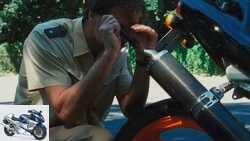
technology & future
Conversion tips exhaust systems
Optics, sound, performance
read more
Every engine layout and every firing order has a special feature
Basically, however, cannot be said about the performance search for different engines. “With single cylinders, longer manifolds bring more midrange power, while shorter tubes generate higher peak performance,” explains the R. & D-man. “However, this formula does not apply to inline four-cylinder engines. And the current Yamaha R1 is a special case anyway because of its crank pin offset. Every engine layout and every firing order has a special feature that you have to consider when developing the exhaust. ”It all sounds pretty complicated – and it is. To go into detail on each design would go beyond the scope of this story. Therefore, we prefer to deal with the engine type that reacts particularly well to exhaust tuning: high-revving (sports) engines that generally work with long valve overlaps (inlet and outlet valve open at the same time).
Because of the long overlap phase, fresh, unburned mixture can get into the outlet at low and medium speeds. Since only the burned mixture generates power and torque, there is often a gap in this speed range. A cleverly designed exhaust smooths out this collapse with targeted reflections of the pressure waves, which positively influence the flow behavior of the fresh gas. This means that this gas stays where it belongs: in the combustion chamber. “Even with engines with less overlap, a good exhaust provides better performance,” adds Klemenc. “It supports the purging of the combustion chamber and frees it of exhaust gas residues.”
Adapted injection program advisable
But simply attaching an accessory exhaust to the bike can also have nasty consequences. Especially with complete racing systems, some machines require a newly programmed injection map. The Test-Kawa is such a bike. With series mapping, it runs too lean, which in the long term can cause engine damage due to overheating. “In these cases, we expressly point this out and recommend appropriate mapping,” says the test manager. However, an adapted injection program is also advisable for less delicate machines. This is the only way for the bike to develop its maximum power.
Most in-line engines with more than two cylinders have small connections between individual manifold pipes. These so-called interferences are used to remove the exhaust gas more quickly. Connected are always those cylinders whose firing order and therefore exhaust cycles are far apart. This ensures that the exhaust gas does not get in each other’s way, reducing performance. Logically, that cannot happen with the KTM factory racers. Whether they can get the Hondas under control again in terms of performance remains to be seen over the course of the season. The new exhaust will soon be used in the Grand Prix.
Technology: types of dampers

Akrapovic
The comparatively simple construction of the absorption damper. Its advantages: light, inexpensive, little counter pressure.
There are basically two types of exhaust mufflers: reflection and absorption silencers. The first variant is more complicated and houses several chambers that are connected with pipes of different lengths and diameters. A sophisticated construction guides the sound waves in such a way that their energy dissipates through overlapping. The individual chambers serve as resonance bodies that create high resistances for certain frequencies and thus dampen the sound. Often there is additional insulation material in a double-walled outer shell in such mufflers, which further reduces the volume. Standard bikes are usually equipped with reflection dampers. Their main advantage is their long shelf life. Disadvantages: high weight, high price, high counter pressure.
Systems with pre-silencers based on the reflection principle and end pots based on absorption are used more and more frequently. The latter have a comparatively simple design: perforated inner tube, jacket made of insulating material (e.g. made of fiberglass), outer shell, end cap. Above all, absorption dampers “swallow” high-frequency sound waves, which means that they usually sound very dull. These dampers are lighter and cheaper than their reflection friends. In addition, they build up less counter pressure, which in principle has a performance-enhancing effect. “Bikes with absorption dampers usually accelerate better,” says R happily & D-man Jaka Klemenc. “To do this, reflection exhausts first have to build up enough pressure in the chambers.” Disadvantage of the absorption design: less durability. Because the flow of exhaust gas gradually hurls the fibers of the insulation material out into the open. Therefore, such pots have to be re-insulated from time to time.
Comparison: measured values

PS
The comparison measured values.
As this experiment shows, exhaust development does not generally depend on the lowest possible counterpressure in the system. The drop in performance between 6000 rpm and 10,000 rpm with the shortened manifold (orange curve) speaks for itself. But the performance development up to this brand is also noticeable – the stub manifold easily keeps up with the racing system and even surpasses it in some cases.
With targeted interventions, the midrange power or the peak performance can be increased. Therefore, an exhaust is always a compromise. The slip-on variant is significantly more powerful than the standard system up to 7000 rpm. The maximum power is also one horse higher (rear wheel measurement).
Brief portrait: Racing Department
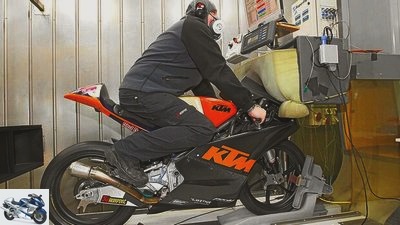
Bilski
Current Moto3 factory racer from KTM in a power check with exhaust as a test vehicle. We were allowed to take the picture because of an ingenious deal between Akrapovic and KTM: “Photo against more ponies.”
Akrapovic’s success depends largely on its commitment to racing. “The experience gained from this is used to develop bikes close to series production,” says the racing department manager with the difficult name Slavko Alojz Trstenjak. There is hardly a series that starts without the Slovenian exhausts. The company has been internationally active since 1996, when Kawasaki knocked on the door. “Worldwide we supply 66 teams including the off-road sector with a total of 174 riders.” The most well-known customers fight for points and honor in MotoGP: Ducati and Yamaha. Akrapovic won the title with the Japanese and Jorge Lorenzo in 2012. Ducati was added for this season. “The Italians are still changing a lot,” ponders the head of racing. “We have designed more than ten variants for them since last summer.”
But that is not always due to the search for more power. Rather, chassis modifications or changes to the seat, for example, require new expansion stages. When asked about the greatest challenge, Trstenjak immediately mentions the Honda VTR 1000 SP 2. “Back then, that was a completely new project for the Japanese and us. We all got really involved and won the Superbike World Championship title in the first year. Between 2000 and 2002 we developed a total of 40 upgrades! ”Akrapovic also designs exhaust systems for exotic engines. In 2005, the Roberts team started in the premier class with a KTM V4 with a Slovenian exhaust. “Over the years, all MotoGP manufacturers have been our customers.”
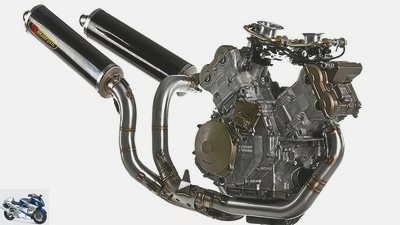
Akrapovic
Tough nut: The world championship project with the Honda VTR 1000 SP 2 between 2000 and 2002 was one of the most extensive.
We don’t know which of these machines blew flames out of the exhaust pipe in a show-like manner. But the head of racing explains how they are created: “It always has to do with the unburned mixture in the exhaust, which is ignited by the high temperatures. For example, it gets into the exhaust through long valve overlaps or through slightly open throttle valves in overrun mode. ”The head of racing, on the other hand, does not provide any information on how high the budget is. “We can’t put a precise figure on that. With every project we learn what is ultimately priceless, ”is the evasive answer.
On the other hand, there is clarity with the staff. Including the boss, nine people take care of the discerning clientele. “In 2013 we developed 240 to 270 upgrades. Somehow we manage to ensure that nobody feels disadvantaged, ”says Trstenjak. Since 2008, the company has been getting more involved in automotive racing. But the two-wheeler sector has nothing to do with that. “We only take care of the motorcycles, there is enough work.” New customers are not excluded.
Brief portrait: Akrapovic

Bilski
Nothing comes from nothing: Akrapovic’s welds are legendary.
As a racer and tuner, Igor Akrapovic recognized the potential of optimized exhaust systems early on and was busy experimenting with the pipe braids as early as the late 1980s. With success. The Slovenian quickly made a name for himself in the scene and founded the Scorpion company in 1990. The international breakthrough came in 1996 when Kawasaki first used the systems in the Superbike World Championship. The first victory followed in 1997. At that time, a lawyer letter from Ford fluttered into the house. The automaker insisted on a change of name, because the sonic proximity to its mid-range model “Scorpio” was too great for the Americans. Since then, the company has been running under the surname of the company founder. What remained is the logo with the scorpion.
The name change did not harm the success, the company continued to grow rapidly. In 1999 the company moved to larger halls within the town of Ivancna Gorica. The success story continues to this day, around 700 people currently work for the company. Double-digit annual growth rates make Akrapovic one of the most successful companies in Slovenia. Another move is due this year. The entire production is outsourced to Crnomelj, around 60 kilometers away. This creates space for new projects, more and more manufacturers are running down the doors of exhaust manufacturers. The Slovenians are now developing exhaust systems even for scooters and custom bikes. They have also been working for the auto industry since 2008. “At the moment we are only overseeing 40 projects for two-wheelers,” says Entwicklungs-
head of Ziga Zadnik. “Ascending trend!”
Buy accessories from Akrapovic at markt.motorradonline.de
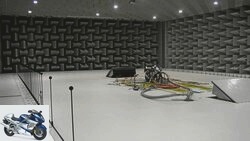
Exhaust & silencer
Exhaust special
Sound hobbyist
read more
With all three variants, the ZX-10R draws a clean performance curve
We are particularly excited about the result with a massively shortened manifold without additional exhaust parts. We would have loved to measure the Kawa without any system. After all, so the idea was that the engine could blow the exhaust gas out into the open with no resistance and thus performance-enhancing. Unfortunately, this attempt is not possible, because the exhaust gases, which are up to 900 degrees Celsius, would have mercilessly grilled the radiator and other attachments of the bike. But even with the short tubes, the performance curve paints a clear picture: massive drop between just over 6000 / min to 10000 / min. According to the technicians, the drop in performance would be even greater without a manifold. Why? More on that in a moment.
First of all, a complete racing system and the standard exhaust make the difference to the minimal version clear. We also put another muffler (slip-on) on the original system. With all three variants, the Kawasaki ZX-10R draws a sparkling clean performance curve from the speed lower to the limiter. The difference is most obvious with the racing system. As a maximum, the Kawa presses exactly 12.5 HP and 11.3 Nm more on the test stand roller at around 7000 rpm than with the shortened manifold. The top-end power on the rear wheel, on the other hand, is a little closer together with 179 hp to 173 hp.
Related articles
-
Akrapovic accesories Akrapovic exhaust test robot Akrapovic exhaust system long-term test Robots as long-term test drivers Exhaust system manufacturer…
-
Tuning special – exhaust systems
Akrapovic 6th pictures Akrapovic. 1/6 Akrapovic has its own exhaust gas laboratory and its own titanium foundry for the direct implementation of new…
-
Brake performance in comparison: MotoGP versus Formula 1
Brembo Sports & scene Motorsport Brake performance in comparison: MotoGP versus Formula 1 Brake performance in comparison: MotoGP versus Formula 1 At the…
-
MV Agusta with Akrapovic as a new exhaust partner
MV Agusta counselor traffic & business MV Agusta with Akrapovic as a new exhaust partner MV Agusta with a new exhaust partner Akrapovic develops for the…
-
Ducati Multistrada V4 with Akrapovic exhaust ex works
Ducati 45 pictures Ducati 1/45 Ducati brings the new Multistrada with a V4 engine. Ducati 2/45 Ducati has made the Multistrada even more versatile….
-
Motorcycle exhaust systems from SR-Racing
fact 18th pictures fact 1/18 Sepp Bruckschlogl is the master of the pipes and head of SR-Racing. fact 2/18 Components of the silencer. fact 3/18 Shapes…
-
Hertneck accesories Exhaust & silencer Exhaust test BMW K 1200 S Exhaust test BMW K 1200 S Investment advice When it comes to top performance, there is…
-
Conversion tips exhaust systems
Hanselmann 8th pictures Debus 1/8 In principle, there are two options when the exhaust is to be replaced. Here is a completely new system from Akrapovic,…
-
Bilski accesories Exhaust & silencer Exhaust test Kawasaki Z 750 Exhaust test Kawasaki Z 750 Listening games Does the Kawasaki Z 750 sound better or just…
-
Schwab Sports & scene History of motorcycle tuning History of motorcycle tuning Tuners have never had it harder Content of About 50 years ago, motorcycle…